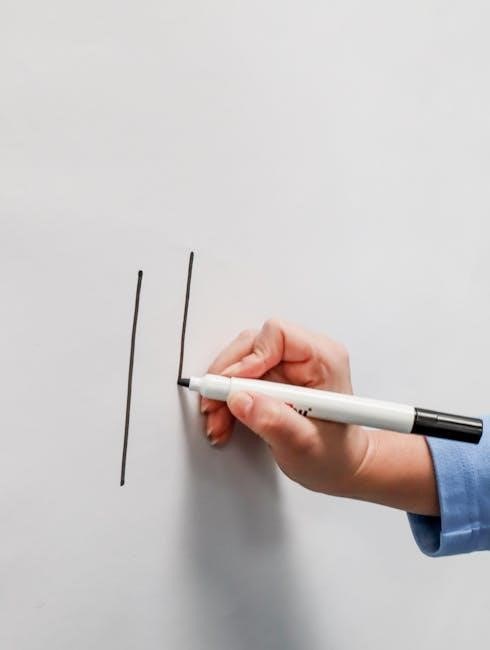Welcome to the Wii U Instruction Manual! This guide provides essential information for setting up, operating, and troubleshooting your Wii U console. It covers console features, accessories, and safety guidelines to ensure a smooth gaming experience.
1.1 Purpose of the Manual
This manual serves as a comprehensive guide to help users understand and utilize the Wii U console effectively. It provides detailed instructions for setup, operation, and troubleshooting, ensuring a safe and enjoyable gaming experience. The manual covers essential features, accessories, and safety precautions, making it an indispensable resource for both new and experienced users.
1.2 Getting Started with the Wii U Console
Unpack the Wii U console, GamePad, and accessories. Connect the console to your TV using the provided HDMI cable. Locate the POWER button on the console and press it to turn it on. Follow the on-screen instructions to complete the initial setup. Refer to this manual for detailed guidance on connecting peripherals and navigating the Wii U menu system.

Wii U Console Hardware Overview
Explore the Wii U console’s components, including the main unit, GamePad, and accessories. Understand their functions and design to maximize your gaming experience.
2.1 Component Names and Functions
The Wii U console features a main unit with a disc slot, power button, and LED indicators. The GamePad includes a touchscreen, analog sticks, and buttons. Accessories like the Wii Remote enhance gameplay. Each component is designed for specific functions, ensuring intuitive control and seamless interaction during gaming sessions. Understanding these parts optimizes your experience.
2.2 Console Views (Front, Rear, and Right)
The Wii U console’s front view includes the disc slot, POWER button, and LED indicators. The rear features ports for HDMI, USB, and AV Multi-Out. The right side offers additional USB ports for accessories. Each view provides access to essential connectors, ensuring easy setup and connectivity for a variety of gaming and multimedia experiences.
2.3 Power Button and LED Indicators
The POWER Button is used to turn the Wii U console on and off. The LED indicators display the console’s current status, with an amber light indicating standby mode and a steady green light showing normal operation. These indicators provide clear visual feedback for users to monitor the console’s power state effectively.
Setting Up the Wii U Console
This section guides you through the process of connecting your Wii U console to a TV, powering it on, and navigating the menu for the first time. Follow these steps to ensure proper setup and functionality.
3.1 Connecting the Console to a TV
Connect the Wii U console to your TV using an HDMI cable. Ensure the TV is set to the correct HDMI input. If no HDMI is available, use a Wii AV Multi-Out cable. Plug one end into the console’s AV Multi-Out port and the other into the TV’s corresponding input. Power on both devices and follow on-screen instructions to complete the connection.
3.2 Powering On the Console
Press the POWER button on the Wii U console or the GamePad to turn it on. Ensure the power LED lights up. If using the GamePad, the screen will activate. Make sure your TV is set to the correct input. The console will boot up, and the Wii U Menu will appear on your TV screen.
3.4 Navigating the Wii U Menu
Use the GamePad to navigate the Wii U Menu. Press the Home button to access the HOME Menu, then select options using the analog sticks or directional buttons. Tap the screen to choose apps or settings. Swipe left or right to switch between menu screens. Access the electronic manual by pressing the button in the lower right corner.

Using the Wii U GamePad
The Wii U GamePad is essential for gaming, featuring a touch screen, buttons, and analog sticks for intuitive control. Use it to play games, access menus, and manage settings seamlessly, enhancing your gaming experience with its versatile design and functionality.
4.1 GamePad Controls and Functions
The Wii U GamePad features a 6.2-inch touch screen, analog sticks, and buttons for gaming. Use the directional pad for movement and face buttons for actions. The HOME button accesses menus, while the touch screen offers intuitive navigation. It also supports language switching and displays in-game manuals for enhanced gameplay convenience and customization.
4.2 Accessing the HOME Menu
To access the HOME Menu, press the HOME button on the Wii U GamePad. This menu allows you to view system settings, access the Nintendo eShop, and manage downloaded software. You can also use it to view notifications and adjust controller settings. The HOME Menu is your central hub for navigating console features and customizing your experience.
4.3 Using the Electronic Manual via the GamePad
Access the Wii U Electronic Manual by pressing the HOME button on the GamePad, then selecting the manual icon. Use the on-screen buttons or directional controls to navigate through sections. The manual provides detailed instructions for using the console, playing games, and troubleshooting. You can also search for specific topics within the manual for quick access to information.
Playing Wii U and Wii Games
Explore the world of Wii U and Wii games. Insert discs, switch modes, and access in-game manuals effortlessly for a seamless gaming experience. Start playing now!
5.1 Inserting and Playing Game Discs
To play Wii U games, insert the game disc into the console’s disc slot with the label facing up; Gently push until it clicks. Power on the console, select the game from the menu, and enjoy. Ensure the disc is clean and handled by the edges to prevent damage. The Wii U supports both Wii U and Wii game discs.
5.2 Switching Between Wii U and Wii Modes
To switch modes, access the Wii U Menu and select the Wii Mode channel. Once in Wii Mode, use Wii Remotes for gameplay. Note that Wii Mode restricts access to Wii U features. Return to Wii U Mode by pressing the B Button on the GamePad. Ensure compatibility with Wii games and accessories in Wii Mode.
5.3 Accessing In-Game Manuals
During gameplay, press the Home button on the Wii Remote to display the Home Menu. Select the electronic manual for the current game to view instructions and controls. This feature provides quick access to guidance without interrupting your gaming experience.

Wii U Accessories and Peripherals
Explore the variety of Wii U accessories and peripherals designed to enhance your gaming experience, including compatible controllers, storage solutions, and more.
6.1 Compatible Controllers and Accessories
The Wii U supports various controllers, including the Wii U GamePad, Wii Remote, Nunchuk, and Classic Controller, each offering unique gaming experiences. Accessories like SD cards expand storage, while others enhance connectivity and convenience, ensuring compatibility with both Wii U and Wii games for a versatile gaming setup.
6.2 Using SD Cards for Data Storage
SD cards can be used to expand storage for Wii U, storing games, apps, and data. Ensure compatibility with SD or SDHC cards up to 32GB. Insert cards into the slot on the Wii U console to transfer or save data, enhancing your storage capacity for a better gaming experience.
6.3 Connecting to the Internet
The Wii U supports 802.11b/g/n wireless networks. Use a wireless router or access point to connect to the internet. Note that access points supporting only 802.11a are not compatible. For secure connections, WEP, WPA, or WPA2 encryption is recommended. Refer to the Wii U Electronic Manual for detailed setup instructions and troubleshooting tips.
Parental Controls and Safety Features
This section explains how to set up parental controls, restrict access to certain features, and ensure a safe gaming environment for all users of the Wii U console.
7.1 Setting Up Parental Controls
To establish parental controls, navigate to the Wii U Menu’s System Settings. Create a PIN to restrict access to certain features, such as game ratings, online interactions, and content purchases. Customize settings to suit your family’s needs, ensuring a safe and controlled gaming environment for all users.
7.2 Restricting Access to Certain Features
Use parental controls to limit access to specific features, such as online gaming, internet browsing, and content purchases. Set restrictions based on game ratings or user profiles. Enable PIN protection to prevent unauthorized changes to these settings, ensuring only approved users can access restricted content or modify system preferences.
7.3 Understanding Data Transfer Options
Transfer data between Wii U and Wii consoles using an SD card or wirelessly. Move saved games, user data, and digital purchases securely. Use Nintendo’s transfer tools to ensure safe migration. Always back up data before transferring to avoid loss. This process allows seamless transitions between consoles while preserving your gaming progress and settings.
Troubleshooting Common Issues
Resolve connectivity problems by restarting the console or checking network settings. Address software issues by updating firmware or reinstalling games. Use LED indicators for diagnostic help.
8.1 Resolving Connection Problems
Check your internet connection by restarting the router and console. Ensure Wi-Fi is enabled and your network password is entered correctly. Verify network settings under the Wii U Menu. Update console software for compatibility. Consult the electronic manual for detailed troubleshooting steps to restore connectivity and enjoy uninterrupted gaming.
8.2 Fixing Software Compatibility Issues
Ensure all games and apps are updated to the latest version. Restart the console and try loading the software again. Check for system updates in the Wii U Menu. If issues persist, refer to the electronic manual or contact Nintendo support for further assistance to resolve compatibility problems effectively.
8.3 Updating Console Software
To update your Wii U console software, navigate to the Wii U Menu and select “System Settings.” Choose “System Update” and follow the on-screen instructions to download and install the latest software version. Ensure your console is connected to the internet and avoid interrupting the update process. If issues arise, restart the console and retry or contact Nintendo support for assistance.

Additional Resources and Support
Explore additional resources and support options for your Wii U, including online manuals, guides, and assistance from Nintendo’s customer support team for enhanced gaming experiences.
9.1 Accessing Online Manuals and Guides
Access online manuals and guides through the Wii U Menu or Nintendo’s official website. Download PDF versions of the Wii U Operations Manual, Health and Safety Information, and specific game manuals. These resources provide detailed instructions for console setup, troubleshooting, and game-specific guidance. Visit the Nintendo Support page for direct links.
9.2 Contacting Nintendo Customer Support
For assistance, visit Nintendo’s official support website. Use the chat feature, submit a help request, or explore troubleshooting guides. You can also contact Nintendo’s customer service team directly via phone or email for personalized help with Wii U-related questions or issues. Find contact details on the Nintendo Support page.
9.3 Downloading PDF Versions of Manuals
Nintendo offers downloadable PDF versions of the Wii U Operations Manual and related documents. Visit the official Nintendo support website and navigate to the Wii U section. Select the desired manual to download. Ensure you have a PDF reader installed. The Wii U Operations Manual is approximately 948 KB, while the Health and Safety Information is 675 KB.
Health and Safety Information
This section provides essential safety guidelines for using the Wii U console and accessories. It includes precautions to ensure safe handling and compliance with regulatory standards.
10.1 Important Safety Precautions
Always handle the Wii U console and accessories with care to avoid damage or injury. Ensure the console is placed on a stable, flat surface away from heat sources. Use only authorized power cords and avoid overloading electrical outlets. Store the console in a cool, dry place and follow all safety guidelines provided by Nintendo.
10.2 Handling the Console and Accessories
Handle the Wii U console and accessories with care to prevent damage. Avoid exposing the console to direct sunlight or extreme temperatures. Clean surfaces gently with a soft cloth and avoid liquids. Store the console and accessories in a protective case when not in use to maintain their condition and functionality.
10.3 Declaration of Conformity
The Wii U console complies with applicable safety and regulatory standards. It adheres to certifications ensuring safe operation and environmental responsibility. For detailed information, refer to the Declaration of Conformity document provided with your console or available online, which outlines compliance with international regulations and standards.
